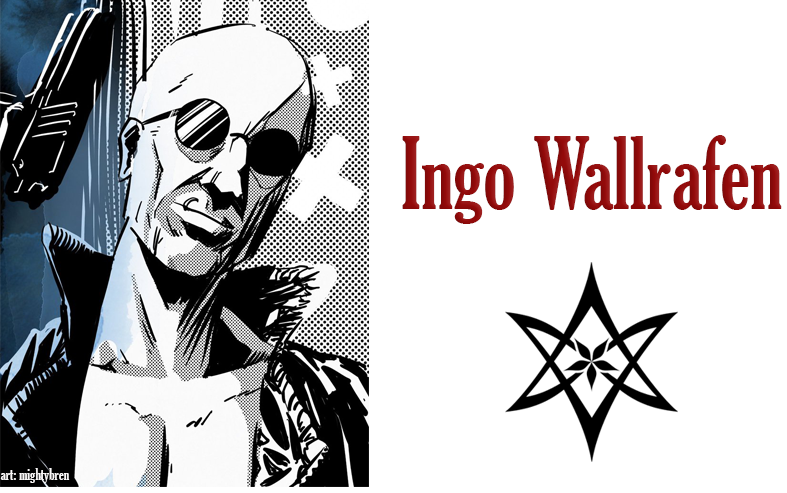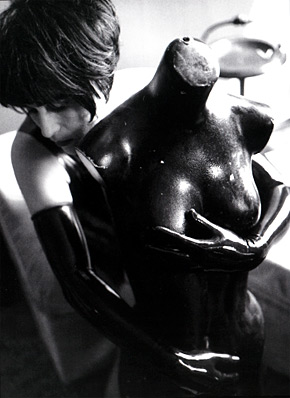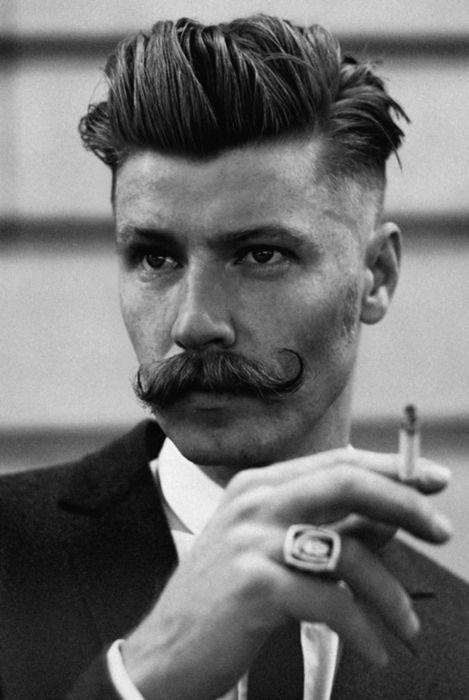Ingo Wallrafen
- At August 17, 2018
- By Great Quail
- In Vampire
 0
0
The best job that was ever offered to me was to become a landlord in a brothel. In my opinion it’s the perfect milieu for an artist to work in.
—William Faulkner
Description
Clan: Toreador antitribu
Affiliation: Byzantium Coven
Role: Sexton, Manager of Club Byzantium
Born in seventeenth-century Amsterdam as a freakishly large baby completely devoid of hair, this Toreador antitribu grew up tall, muscular, and unexpectedly handsome. He favors simple clothing, usually tight-fitting jeans and paisley shirts, and is rarely seen without a black leather jacket and round sunglasses. Ingo carries himself with a sexy confidence, and there’s a dangerous edge to his charisma that some women find irresistibly attractive. He can be incredibly charming and generous, but he also has the capacity to be an brutish asshole—as Calista Joyce once said, “he’d make the perfect blind date for a Brontë sister.”
History
The only son of a fabulously wealthy bewindhebber, Ingo was groomed from birth to join his father as a shareholder and officer in the Dutch East Indies Company. He was a remarkably capable young man, intelligent and cunning. Naturally, the moment his father hailed him as the “perfect son and heir,” Ingo ran away from home. He was sixteen years old. His father spend thousands of guilders searching for his rebellious issue. Only one agent actually discovered his whereabouts, and Ingo blackmailed him into silence. Ingo was soon enjoying the life of a classically dissipated libertine, living in a whorehouse and sketching his favorite prostitutes. Finding work as an erotic engraver, he began creating private pornography for exclusive clientele. In 1797, his illustrations for the Marquis de Sade’s Justine/Juliette gleefully scandalized the salons of France, and Ingo entered the orbit of the Parisian Toreador.
In 1801, Ingo was Embraced by El Madrugador, a flamboyant Spaniard who claimed to have been in El Torero’s original coterie. Along with El Madrugador’s other progeny Grenadier Toil and Imanol Extarte, they formed a small coterie that explored the darker corners of the Toreador lifestyle and flirted with Sabbat ideology. As Napoleon rose to power, France became increasingly more dangerous to Cainites, and the group disbanded in 1811. El Madrugador moved to Barcelona and joined the Sabbat, Grenadier emigrated to the Dominion of Canada, and Imanol changed his name to Emmanuel Mammon and vanished somewhere in colonial Egypt. Ingo returned to Amsterdam, reuniting with his estranged family and helping his father through his final days on his deathbed.
Joining the Dutch Camarilla, Ingo used his Parisian connections and his abundant family resources to steadily ascend the ranks. His sex appeal certainly helped, too, and Ingo became quite popular, the “worldly Toreador” among the sober enclave of Ventrue. Ingo frequently seized upon opportunities to travel, which gave him license to satisfy cravings not condoned by his staid Camarilla masters. After meeting Malachi Voordebrax in the Dutch East Indies, Ingo joined the Tzimisce “playing the Osiris game” in Sumatra; in Martapura, he betrayed a Ventrue business rival to vampire hunters working for Sultan Hidayatullah. Devious but cautious, Ingo always managed to cover his tracks, and in 1898 the Prince of Amsterdam appointed Ingo Wallrafen to the Primogen Council.
It was not a wise decision for either party. Vexed by the increasing demands of the Masquerade as modernity forced more vampires into secrecy, Ingo’s boredom soured to disaffection and finally contempt. Shortly after the Second World War he allowed himself to be recruited to the Sabbat by Grenadier Toil, now a sexton in New York City. Ingo functioned as a double-agent for two decades, using his position on the Primogen Council to ensure Barcelona’s quiet expansion. In 1968 he was unmasked by his model and lover, a Toreador ingénue seeking to elevate her position in the Camarilla. Ingo escaped the Netherlands and sought refuge with Grenadier in New York City.
Weary of ceaseless political maneuvering, Ingo was content to simply pursue his muse, and New York in the seventies was the perfect time and place for a man of his talents. Exchanging his engraving tools for a Hasselblad, Ingo made a name for himself as a fetish photographer, a contemporary of Helmut Newton, Eric Kroll, and Nobuyoshi Araki. He was one of the first photographers to be published by Benedikt Taschen, and even had the mandatory secret fling with Madonna. Ingo was finally happy.
Current Role
In 1990, the unexpected death of Grenadier Toil rocked the Byzantium Coven to its core. After consulting with Malachi, Venus asked Ingo to once again grasp the twin nettles of business and politics. He agreed only reluctantly, and became the coven’s sexton—a position that includes the operation of Club Byzantium as a Cainite haven as well as an ongoing financial concern. While Ingo still devotes time to photography, his commercial genius cannot help but exert itself, and the coven’s network of clubs have flourished under his stewardship. Combining an admirable Dutch pragmatism with a low tolerance for nonsense and a silver-loaded .45, Ingo keeps the coven refreshingly free from drama—no easy task among a collection of divas and sex addicts!
Notable Cambions
Dagmar Seidel, “Mistress Engel Schiekron”
No stranger to sharing his vitae with human lovers, Ingo’s closest companion is his oldest cambion, a German fetish designer named Engel Schiekron. Born in Berlin in 1964 as Dagmar Seidel, the future “Angel of Lust” was raised by bohemian parents who owned a trendy clothing store off the Kurfürstendamm and dabbled in the world of key parties and wife-swapping. Running away to New York at the age of 17, Dagmar settled into an apprenticeship at a leather shop in the West Village. Two years later, she opened “Ku’damm,” a small store on the Lower East Side serving the BDSM community. Dagmar began selling her wares at Sarnath, where she came into contact with the Sabbat. Accepting increasingly more fascinating commissions from Malachi and his circle, she was eventually introduced to Ingo Wallrafen, who transformed her into a cambion in 1992. Undertaking the Rites of Amizu, Dagmar Seidel adopted the coven name “Engel Schiekron.”
Schiekron’s new clientele were demanding, but they were affluent and paid handsomely. In 1996 she launched Pharzuph, an upscale fetish boutique near St. Mark’s Place. Open by appointment only, Pharzuph caters to select clients, and its high prices reflect this exclusivity. Schiekron’s talent encompasses a broad spectrum of styles, but she is best known for her handcrafted leatherwork, often patterned on Victorian designs and boasting copious fripperies. Pharzuph has become the premiere boutique for American Tzimisce in search of bespoke leatherwear, from outfits tailored to the more extreme forms of Vicissitude to those employing “exotic” leathers on a strict no-questions-asked policy.
Currently satisfied with her status as an ageless ghoul, Schiekron expects to eventually be Embraced as a Toreador; but not by Ingo Wallrafen. The two have been enjoying an open relationship for decades, and Schiekron is reluctant to shift the dynamic from “master-and-servant” to “master-and-slave.” Instead, Schiekron has suggested Ingo’s blood-brother, the Parisian designer Emmanuel Mammon. That the Basque antitribu has been known to impulsively kill his prospective progeny only adds to the allure.
Lazlo Black
Manager of Viriconium—Toreador cambion
A swarthy man of medium build who proudly sports a tycoon moustache, Lazlo Black looks like he stepped out of a vintage mug shot. Not that he’s unattractive—there’s a sensuality to his hooded eyes, and his drowsy manner conceals a mind that pays close attention to every detail, always ready with a perceptive remark or a well-timed compliment. Born in Missouri in 1892, Lazlo owned St. Louis’ most notorious brothel, the House of the Good Shepherd. Babe Ruth’s favorite bordello, the Shepherd was located in a warehouse at the corner of Forest Park Avenue and Boyle Street, and was managed by a heavyset, jovial madam named Sally Binkley. The Shepherd was renowned for its luxurious rooms and quality meals; Babe himself was rather fond of the “exquisitely aged steaks” and Sally’s famous biscuits and gravy. After the Shepherd closed in the mid-thirties, Lazlo and Sally relocated to New York, where they eventually encountered Robert and Kitty Plant’s operation. Recognizing their talent for running a good cathouse, the Plants “recruited” Lazlo and Sally by changing them into ghouls in 1942.
Lazlo considered himself more an artist than a criminal, and resented being the ghoul of a lowly Nosferatu. He began courting the Toreador and Daeva at the Dakinī Club, but the stink of the Plants was tainting his veins, and the best he received was polite deferral. In 1956 Sally refused to drink any more of Kitty’s vitae, and “retired” to a normal life running a bakery in Hell’s Kitchen. In 1968 Lazlo finally convinced Grenadier Toil to take a private meeting. The enghouled entrepreneur presented his idea to transform one of the Plants’ abandoned subway stations into an upscale underground bordello tentatively named “Station Bluelight.” Grenadier gave his permission and informed the Plants that Lazlo required a promotion. Lazlo developed the brothel with the reluctant assistance of Roger Plant, and Station Bluelight opened for business in 1972. After a few years of expansion and success, Venus requested a name change to better suit the Byzantium aesthetic, and “Viriconium” was born.
Acknowledging Lazlo as the impresario he always imagined himself to be, Grenadier replaced Roger Plant as his master, and Lazlo finally got what her wanted—sweet, sweet Toreador blood. It may have cleared up his degenerating complexion and reversed his increasingly bowlegged gait, but it didn’t summon any muse of fire from his blood, and Lazlo continued on much as before. After Grenadier’s plane went down over the sunny fields of France, Ingo Wallrafen offered to Embrace Lazlo. The cambion surprised the coven by declining, indicating that he planned to “follow Sally to the grave” when the time came. Whether or not he’ll change his mind is anyone’s guess, as Sally Binkley is still alive, sharp as a tack and showing little signs of decline. In the meantime, Lazlo continues to operate Viriconium, and has recently been granted a permanent residence on Byzantium’s fifth floor.
Sources & Notes
The core of the Gotham Sabbat was first uploaded on 31 October 2000, but the Byzantium Coven was extensively revised during the August 2018 update. Ingo Wallrafen’s physical appearance was inspired by Grant Morrison’s Invisibles character “King Mob.” The King Mob illustration in the banner is by the artist Mightybren. Calista’s joke about the Brontë sisters is a shout-out to one of my favorite comics, Hark! A Vagrant.
The photograph of “Mistress Schiekron” was lifted from Steve Diet Goedde’s book The Beauty of Fetish, and the photograph of “Lazlo Black” was borrowed from a Tumblr about men with moustaches. The House of the Good Shepherd was a real brothel, mentioned in Kal Wagenheim’s book, Babe Ruth: His Life and Legend. I can’t find any reference to the establishment outside its connection to Babe Ruth, so it’s possible that “The House of the Good Shepherd” was Babe Ruth’s humorous nickname for the brothel. Sally was the brothel’s historical madam, but Lazlo Black is fictional.
Author: Great Quail
Original Upload: 31 October 2000
Last Modified: 3 September 2018
Email: quail (at) shipwrecklibrary (dot) com
PDF Version: [Coming Soon]



